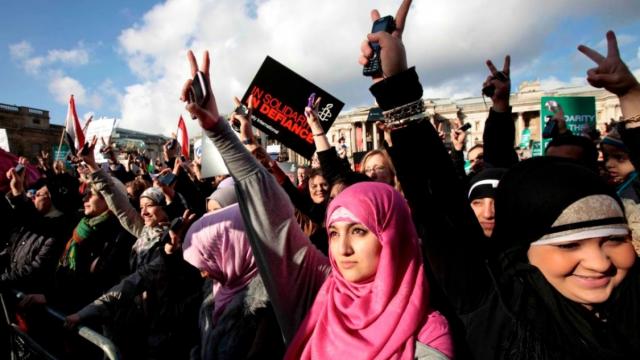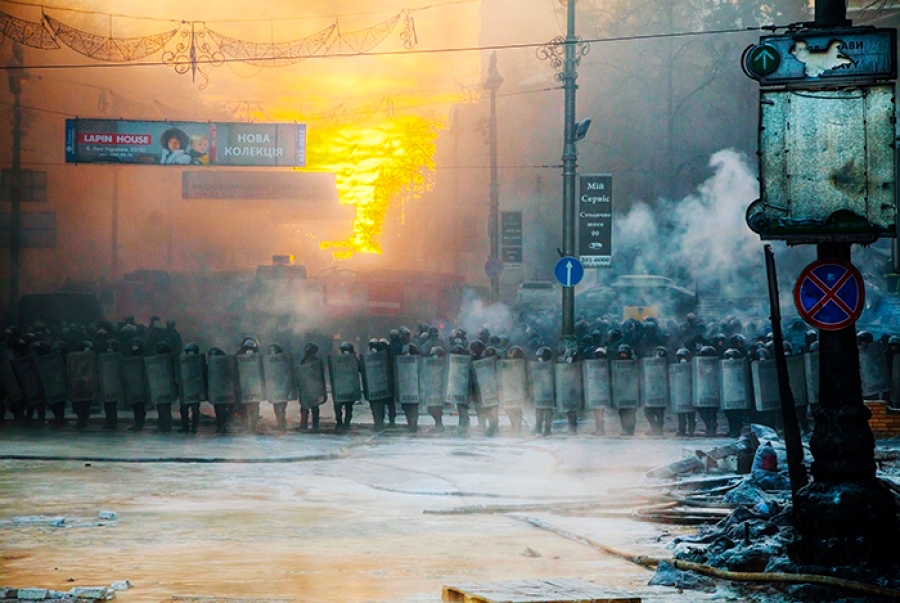
One after another, they fill front-page headlines—Tehran, Tahrir, Wall Street, Puerta del Sol, Gezi Park, Euromaidan, Hong Kong.
Some of these protest movements have disappeared, crushed either by terrified governments or hijacked by competing political forces; some still exist, albeit in a smaller form that makes few headlines. Several ultimately sparked some of the worst international crises on our global agenda today.
And the protest sentiment is not going away anytime soon.
Protests—like all social movements—come in waves.
The last time the world saw such a high number of protests was 1989, bringing down the Berlin Wall and—according to scholars like Samuel Huntington—cementing democracy’s Third Wave. But the end of the Cold War was not, as Francis Fukuyama argued in 1989, the end of history. As far as citizen protests go, history was quiet during the Pax Americana years, seeing spikes in protest activity around the Iraq War and Ukraine’s Orange Revolution.
According to Kalev Leetaru, creator of the GDELT Project, “the elevated protest activity of the past three years is only noticeable because it comes on the heels of two decades of relatively reduced protest action.” Using data collected from various news sources in nearly 100 different languages over the past 30 years to measure protest activity month by month, this “protest intensity” measurement corrects for the exponential rise in media outlets in recent years. Our general sense that there are so many more protests now than ever before may be somewhat of an illusion. However, while this may measure the number of protests, it does not measure their impact. In a map by Haisam Hussein of Lapham’s Quarterly showing political revolutions through time, it is clear that the number of highly politically significant protests has reached an all-time high in the past decade.
Where It Began
Just as the revolutions of 1848 set the template for protests in the century and a half following, there was one protest that kicked off the current wave with a new template: viral, horizontal, with no figure as a sole leader, but rather loosely organized around gathering in an urban public space to collectively express disaffection and citizenship.
That protest was not in Tahrir Square, but rather a movement two years earlier and nearly 2000 km further east—in Tehran. On June 12, 2009, the Islamic Republic of Iran announced that incumbent President Mahmoud Ahmadinejad had won his reelection campaign in a landslide against opposition candidate Mir-Hossein Mousavi. Angered by the apparent election corruption, thousands of people took to the streets to protest the results. Although the movement was supportive of Mousavi and other opposition leaders, it was not led by them. More importantly, the Green Movement became the first major protest to be organized primarily through the horizontal platforms of social media, informing followers of when and which public space the next gathering would be. As the crackdown from the Iranian government intensified, the fuse of social media to spread images and video—such as the graphic video of Neda Agha-Soltan dying of a gunshot wound in the street—virally brought more attention and support to the cause.
While the Green Movement was unsuccessful (and indeed, there are doubts it could ever have been successful in Iran’s highly bureaucratized political system), the societal impact of the six months of protests are still felt—in the model of “occupying” public spaces and horizontal organization (seen in Tahrir Square and the Arab Spring, Occupy Wall Street, Gezi Park, Brazil, the Euromaidan, Hong Kong, and more), as well as in the pattern of government response.
#Disaffection
But why now? Why, after two decades of relative calm following the end of the Cold War, are we experiencing this new wave of protests? The most important factors are the defining characteristics of the post-Global Financial Crisis era: growing political disaffection, increasing economic inequality, and the explosion of new and more democratic media outlets.
Political Disaffection
“People have a better understanding of power,” Paul Mason, economics editor of BBC2's Newsnight and author of Why It's Kicking Off Everywhere: The New Global Revolutions, wrote. “Young people believe the issues are no longer class and economics, but simply power: they are clever to the point of expertise in knowing how to mess up hierarchies and see the various 'revolutions' in their own lives as part of an 'exodus' from oppression, not—as previous generations did—as a 'diversion into the personal'."
Today’s protest movements do not attract the same demographics that movements of the 19th century did. Today’s protesters are middle class, highly educated, and more often than not, part of one of the first generations to have such characteristics in the emerging world. Even more so, they are young, and either un- or underemployed. These are grounds to better understand the power dynamics in their communities than generations before, and they are more and more aware of its abuse.
That is why so many of these protests are sparked by a political decision—for example, former Ukrainian President Yanukovich’s decision to cancel negotiations on forming a trade alliance with the European Union in favor of better relations with Russia; or crowds gathered in Gezi Park to protest the decision to turn the public space into a shopping mall. These people feel increasingly alienated from the decision-making processes that ultimately affect their communities and livelihoods, and are fed up with corruption and the shrinking spaces to have their voices heard. According to Saskia Sassen, sociology professor at Columbia University, this is why the tactic of taking over and “occupying” public spaces has been the distinguishing characteristic of this protest wave. She writes, "Whether in Egypt, the U.S., or elsewhere, it is important that the aim of the occupiers is not to grab power. They were and are, rather, engaged in the work of citizenship, exposing deep flaws and wrongs in their polity and society.”
One result of this disaffection with traditional political models and emphasis on horizontalism has been the role women have increasingly played in sparking and pushing forward these movements. In Iran, women were among the most vocal activists. In Egypt, women were prominent among the original organizers calling for people to come out to Tahrir Square. In India, when a 23-year-old medical student died after being gang-raped on a public bus, women turned out in droves to protest the lack of protection from the state for them. For these women, these protests are an attempt to “mess up” traditional hierarchies that often place their security and rights below broader economic development and commercialization.
Economic Inequality
In the West, the driving force behind the wave of protests—from Puerta del Sol to Occupy—has been skyrocketing levels of economic inequality. Occupy Wall Street targeted banks that triggered the Global Financial Crisis and walked away unpunished; as that movement died down after its eviction from Zuccotti Park, Occupy shifted its focus to community-based projects, such as Hurricane Sandy aid, fighting to stop foreclosure proceedings, and most recently, buying out then cancelling student loan debt in its Rolling Jubilee campaign.
In Europe, especially in areas of double-digit youth unemployment, protests have been expressed in both peaceful marches and occupations, and more violent riots (Sweden, UK) or increased political extremism (Greece).
It is not difficult to understand the anger behind this. In the United States, the richest 1 percent of the population owns 34 percent of accumulated wealth; the top 0.1 percent owns 15 percent. Meanwhile, inflation-adjusted wages for low- and middle-income workers have been declining since the 1970s, squeezing these groups more and more. Thomas Piketty, in his unlikely best seller Capital in the Twenty-First Century, stated that income inequality is “higher than in any other society at any time in the past, anywhere in the world.” It’s a recipe for a tinderbox.
This led Tom Malleso to argue in his book, After Occupy: Economic Democracy for the 21st Century, for a reexamination of our economic models, including the very hierarchy between boss and employee. “It is like we have erected a wall down the middle of society, and said that in this half, the economy, there is no need for democracy, while at the same time insisting on calling society as a whole ‘democratic’…people ought to have equal formal decision-making power in their core economic associations: workplaces, finance, and investment institutions.”
Democratization of Media…and Propaganda
Much ink has been spilled on the role of social media in this wave of protests—from organizing marches in Tehran to promoting a dialogue with the outside world in Hong Kong. As people grow accustomed to being able to reach out and communicate directly with anyone, regardless of position or power, on a social media network, they will grow increasingly demanding of having their voices heard at the decision-making table.
But just as social media is effective in spreading up-to-the-minute news and promoting dialogue, it is also increasingly being manipulated to spread clever propaganda and misinformation.
“During the Cold War, things were black and white. Now, things are much more colorful,” stated Nenad Pejic, Editor-in-Chief of RFE/RL at a panel discussion in Washington, D.C.
News and access to information and other opinions or viewpoints has never been so freely available, but with increasingly curated social media feeds and targeted advertising, chances are that what we find and read online is filtered, promoting confirmation bias. Social media may not only increase physical and social isolation, but also ideological isolation.
This creates an environment ripe for misinformation campaigns, where organizations can spread incorrect and sensationalized stories like wildfire through targeted communities, increasing cynicism of traditional media outlets and democratic institutions.
One of the most successful attempts at this is RT News, created with the intention of putting alternative arguments to dominant Western media stories out for public consumption. Tania Chomiak-Salvi of the U.S. Department of State expressed the U.S. Government’s concern about this on the previously-mentioned panel: “While we were distracted by other issues, [Russian] President Putin has built a vast disinformation machine. We are impressed by how audacious it is.“ Anti-government protests and separatist movements in Ukraine have been a testament to the success of this strategy.
This brings us back to 2009 in Tehran. Part of the reason the Iranian government was successful in crushing the Green Movement was due to its willingness to repress freedom of speech—targeting and harassing journalists, shutting down access to global social media sites, and eventually working toward building an Iran-only intranet that provides access to approved websites only. This pattern is being repeated all over the world: social media sites are restricted; Russia is considering its own intranet; leaders, including the Obama Administration, are working overtime to control the message that comes out of their offices; governments around the world are tracking their citizens’ digital activity. Global harassment of journalists is at record levels, according to the Committee to Protect Journalists.
Can the two defining characteristics of this decade’s wave of protests—social media communication and “occupying” of public spaces—each be effectively used without the other? Or, now that governments have seen the power of democratized technology in the Arab Spring, will the increasing restrictions on freedom of speech through social networks stifle democracy’s Fourth Wave before it gains momentum? Time can only tell.
3 WAYS TO SHOW YOUR SUPPORT
- Log in to post comments












